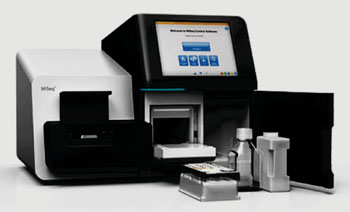DNA Technology Diagnoses Cases of Tuberculosis Faster
By LabMedica International staff writers
Posted on 22 Dec 2015
The protracted Mycobacterium tuberculosis complex (MTBC) diagnosis and phenotypic drug susceptibility testing (DST) is due to slow growth in culture and contribute to reported treatment initiation delays of 8 to 80 days.Posted on 22 Dec 2015
Although genotypic assays can in less than a day identify mycobacterial species and mutations conferring MTBC drug resistance independent of culture, they do not detect all resistance-conferring mutations and are typically still used after microbial culture.

Image: MiSeq Next-Generation Sequencing System (Photo courtesy of Illumina).
A team of international scientists led by those at The John Radcliffe Hospital (University of Oxford; Oxford, UK) compared sequencing mycobacteria from all newly positive liquid cultures with routine laboratory diagnostic workflows across eight laboratories in Europe and North America for diagnostic accuracy, processing times, and cost between September 6, 2013, and April 14, 2014. Routine diagnostic procedures at all centers included species identification and culture with isoniazid, rifampicin, ethambutol, and pyrazinamide to establish drug susceptibility.
The teams sequenced specimens once using local MiSeq platforms (Illumina; San Diego, CA, USA; www.illumina.com) and processed data centrally using a semi-automated bioinformatics pipeline. They identified species or complex using gene presence or absence, predicted drug susceptibilities from resistance-conferring mutations identified from reference-mapped MTBC genomes, and calculated genetic distance to previously sequenced UK MTBC isolates to detect outbreaks.
The scientists used whole-genome sequencing (WGS) and were able to detect presence of tuberculosis (TB) and whether it was resistant to commonly used antibiotics within one week that is up to eight times faster than utilizing traditional diagnosis methods. Compared with routine results, WGS predicted species with 93% accuracy in 322 of 345 specimens; 356 mycobacteria specimens submitted, and drug susceptibility also with 93% accuracy in 628 of 672 specimens; 168 MTBC specimens identified, with one sequencing attempt. The innovative technology also proved more cost effective, at an average cost of GBP 481 per positive case, compared to GBP 517 per case using current technologies.
Louise J Pankhurst, PhD, the lead author of the study, said, "This is a really exciting time to be working in infectious disease research. The UK is poised to become the first country in the world to replace traditional tuberculosis diagnosis with whole genome sequencing. Our study has shown how this will dramatically speed up the time taken to diagnose TB, helping patients be placed on the most effective treatment as soon as possible and reducing the risk of disease transmission.” The study was published on December 4, 2015, in the journal Lancet Respiratory Medicine.
Related Links:
The John Radcliffe Hospital
Illumina













